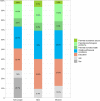Inequality of opportunity in a land of equal opportunities: The impact of parents' health and wealth on their offspring's quality of life in Norway
- PMID: 36068512
- PMCID: PMC9450446
- DOI: 10.1186/s12889-022-14084-x
Inequality of opportunity in a land of equal opportunities: The impact of parents' health and wealth on their offspring's quality of life in Norway
Abstract
Background: The literature on Inequality of opportunity (IOp) in health distinguishes between circumstances that lie outside of own control vs. efforts that - to varying extents - are within one's control. From the perspective of IOp, this paper aims to explain variations in individuals' health-related quality of life (HRQoL) by focusing on two separate sets of variables that clearly lie outside of own control: Parents' health is measured by their experience of somatic diseases, psychological problems and any substance abuse, while parents' wealth is indicated by childhood financial conditions (CFC). We further include own educational attainment which may represent a circumstance, or an effort, and examine associations of IOp for different health outcomes. HRQoL are measured by EQ-5D-5L utility scores, as well as the probability of reporting limitations on specific HRQoL-dimensions (mobility, self-care, usual-activities, pain & discomfort, and anxiety and depression).
Method: We use unique survey data (N = 20,150) from the egalitarian country of Norway to investigate if differences in circumstances produce unfair inequalities in health. We estimate cross-sectional regression models which include age and sex as covariates. We estimate two model specifications. The first represents a narrow IOp by estimating the contributions of parents' health and wealth on HRQoL, while the second includes own education and thus represents a broader IOp, alternatively it provides a comparison of the relative contributions of an effort variable and the two sets of circumstance variables.
Results: We find strong associations between the circumstance variables and HRQoL. A more detailed examination showed particularly strong associations between parental psychological problems and respondents' anxiety and depression. Our Shapley decomposition analysis suggests that parents' health and wealth are each as important as own educational attainment for explaining inequalities in adult HRQoL.
Conclusion: We provide evidence for the presence of the lasting effect of early life circumstances on adult health that persists even in one of the most egalitarian countries in the world. This suggests that there may be an upper limit to how much a generous welfare state can contribute to equal opportunities.
Keywords: AX: Anxiety & Depression; Abbrevations; CFC: Childhood Financial Conditions; Childhood circumstances; EQ-5D; GDP: Gross Domestic Product; HRQoL: Health-Related Quality of Life; IOp: Inequality of Opportunity; ITH: Intergenerational Transmission of Health; Inequality of opportunity; Intergenerational transmission of health; MO: Mobility; PD: Pain & Discomfort; SC: Self-Care; UA: Usual Activities.
© 2022. The Author(s).
Conflict of interest statement
The authors declare that they have no competing interests.
Figures
Similar articles
-
Inequality in quality-adjusted life expectancy by educational attainment in Norway: an observational study.BMC Public Health. 2023 May 3;23(1):805. doi: 10.1186/s12889-023-15663-2. BMC Public Health. 2023. PMID: 37138293 Free PMC article.
-
A cross sectional survey on health-related quality of life among parents of children with allergic symptoms using the EQ-5D-5L.J Asthma. 2019 Nov;56(11):1239-1245. doi: 10.1080/02770903.2019.1571086. Epub 2019 Jan 31. J Asthma. 2019. PMID: 30702001
-
Health-related quality of life of long-term patients receiving opioid agonist therapy: a nested prospective cohort study in Norway.Subst Abuse Treat Prev Policy. 2020 Sep 3;15(1):68. doi: 10.1186/s13011-020-00309-y. Subst Abuse Treat Prev Policy. 2020. PMID: 32883319 Free PMC article.
-
Amplified disparities: The association between spousal education and own health.Soc Sci Med. 2023 Apr;323:115832. doi: 10.1016/j.socscimed.2023.115832. Epub 2023 Mar 11. Soc Sci Med. 2023. PMID: 36947992
-
Are We Agreed? Self- Versus Proxy-Reporting of Paediatric Health-Related Quality of Life (HRQoL) Using Generic Preference-Based Measures: A Systematic Review and Meta-Analysis.Pharmacoeconomics. 2022 Nov;40(11):1043-1067. doi: 10.1007/s40273-022-01177-z. Epub 2022 Aug 23. Pharmacoeconomics. 2022. PMID: 35997957 Free PMC article.
Cited by
-
Inequality of opportunity in child nutrition in Pakistan.PLoS One. 2025 Feb 21;20(2):e0318425. doi: 10.1371/journal.pone.0318425. eCollection 2025. PLoS One. 2025. PMID: 39982904 Free PMC article.
References
-
- Whitehead M. The concepts and principles of equity and health. Int J Health Serv. 1992;22(3):429–45 (p. 431). - PubMed
-
- Roemer JE. Equality of opportunity: A progress report. Soc Choice Welf. 2002;19(2):455–71.
-
- Roemer, J.E. Theories of distributive justice. Cambridge: Harvard University Press; 1998.
-
- Trannoy A, et al. Inequality of opportunities in health in France: a first pass. Health Econ. 2010;19(8):921–38. - PubMed
-
- Rosa Dias P. Inequality of opportunity in health: evidence from a UK cohort study. Health Econ. 2009;18(9):1057–74. - PubMed
Publication types
MeSH terms
LinkOut - more resources
Full Text Sources


